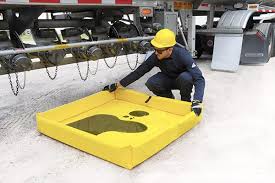Industrial facilities—especially those in agriculture, chemicals, brewing, mining, and similar sectors—regularly manage hazardous or corrosive liquids in large volumes. With this comes an ongoing risk of leaks, spills, and environmental contamination. A major spill doesn’t only threaten health and safety; it can also lead to costly downtime, regulatory penalties, and long-term damage to a company’s reputation.
Fortunately, preventing disasters is often a matter of consistent planning and using the right spill containment systems. Below are simple, practical strategies that help businesses stop small leaks from becoming large-scale incidents.
Table of Contents
- Conduct Regular Risk Assessments
- Stay Compliant with Environmental Regulations
- Invest in Proper Spill Containment Systems
- Maintain Equipment to High Standards
- Train Staff in Spill Prevention and Response
- Keep a Well-Stocked Spill Kit On Site
- Turning Prevention into Practice
Conduct Regular Risk Assessments

Understanding where and how spills might occur is the foundation of prevention. Regular risk assessments should cover all storage, handling, and transportation areas involving bulk liquids or chemicals. This includes:
- Checking chemical compatibility
- Reviewing loading and unloading procedures
- Inspecting seals, valves, pipework, and storage areas
- Ensuring spill response plans are updated and effective
By identifying weak points early, operators can fix issues before they turn into serious hazards.
Stay Compliant with Environmental Regulations
Every region has strict rules governing hazardous substances, including requirements for secondary containment, proper labelling, storage, and disposal. Staying compliant not only avoids fines but also strengthens safety and operational discipline.
Refer to your local EPA or Safe Work guidelines to ensure your spill containment systems meet current standards.
Invest in Proper Spill Containment Systems
Secondary containment is essential for any site handling significant quantities of liquid chemicals. Effective spill containment systems—such as bunding, sumps, and covered IBC bunds—add a crucial layer of protection against leaks and overflow.
For example, outdoor chemical storage can greatly benefit from a covered IBC bund. It prevents rainwater intrusion, reduces overflow risks, and helps maintain compliance. Matching the right containment system to the chemical type and environmental conditions is vital.
Maintain Equipment to High Standards
Components like hoses, seals, valves, and gaskets deteriorate over time. A strong preventive maintenance plan should include:
- Regular visual inspections
- Pressure testing and integrity checks on tanks and containers
- Immediate replacement of worn components
Ignoring minor wear-and-tear can lead to major failures under pressure. Staff should be trained to report issues early and act promptly.
Train Staff in Spill Prevention and Response
Human error is still one of the biggest contributors to industrial spills. Employees must be trained not only in emergency response but also in everyday preventive practices, such as:
- Safe filling and transfer techniques
- Correct use of PPE
- Emergency shutdown procedures
Hands-on drills help ensure everyone knows their role during an incident and reacts quickly and correctly.
Keep a Well-Stocked Spill Kit On Site
Even with strong spill containment systems, small leaks can happen—and responding quickly is key. Spill kits should be strategically placed in storage, filling, and transport areas and equipped with:
- Absorbent pads and socks
- Drain covers
- Hazardous waste bags
- PPE (gloves, goggles, etc.)
Regularly check and replenish kits to ensure they’re ready for immediate use.
Turning Prevention into Practice
Major spill disasters rarely stem from a single factor. They usually result from several missed opportunities for prevention. Through consistent risk assessment, proper spill containment systems, equipment maintenance, and strong staff training, industrial facilities can build a solid safety culture.
These simple measures aren’t just about compliance—they’re a long-term investment in safety, sustainability, and operational reliability.





